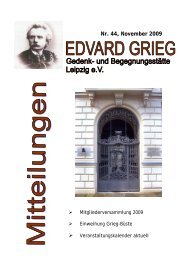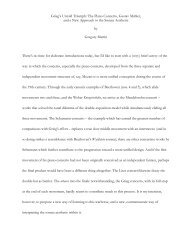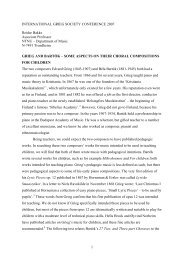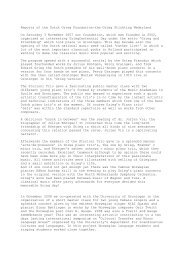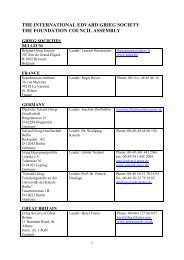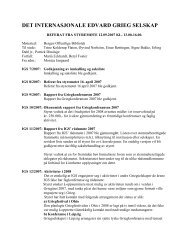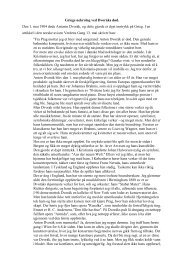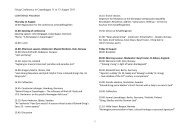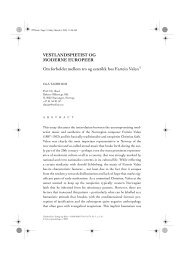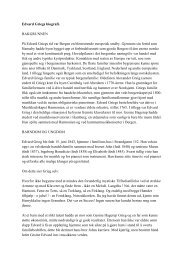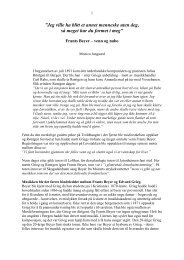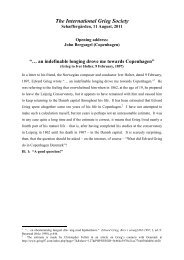Gregory Martin - paper 2007 - Grieg Society
Gregory Martin - paper 2007 - Grieg Society
Gregory Martin - paper 2007 - Grieg Society
You also want an ePaper? Increase the reach of your titles
YUMPU automatically turns print PDFs into web optimized ePapers that Google loves.
og nyere norske Fjeldmelodier (Older and Newer Norwegian Mountain Melodies, 1858;<br />
volume two, number fourteen). While the tune had migrated from Germany to Norway<br />
over the course of several hundred years with various sacred and secular texts, 14 <strong>Grieg</strong><br />
found it paired with the following text:<br />
E kann so mangen ein’ vakker Sang I know so many lovely songs<br />
um fagre land uti Væra,<br />
of fair lands throughout the world,<br />
men aldør ha e no høyrt ei Gøng<br />
but never have I heard a song<br />
dei sang um dœ o ser næra,<br />
of things close to us.<br />
derfor vil e no prøvø paa<br />
Therefore shall I now attempt<br />
o gjera Visa so Følk kan sjaa<br />
to write a song so people will see<br />
at o her Nora kunna vera bra<br />
that even the North can be beautiful<br />
um dœ foragta der søre. though despised by the South. 15<br />
Such earnest nationalism surely rang true with his allegiance to Norway and his<br />
devotion to the development of a Norwegian art, but <strong>Grieg</strong> used folksong throughout his<br />
career and the text of “The Northland Peasantry” can be seen as a credo for his entire<br />
life’s work. How are these elements uniquely engaged in this work? And why use a song<br />
without any real story, so to speak, as the foundation for a work so self-consciously<br />
aligned with an unmitigated narrative genre? Perhaps the answer lies in <strong>Grieg</strong>’s view of<br />
the historical course of folksong: “The music of each nation proceeds in the course of<br />
time from the folk song through the small forms and then into the larger, richer, more<br />
complex forms.” 16 The key sentiment in the text is “I now attempt to write a song.” But<br />
<strong>Grieg</strong>’s narrative is not just of a declamation of intent by some nameless skald. Rather, it<br />
is a chronicle of that attempt’s progress. Containing both the folksong itself and its<br />
‘larger,’ evolved form, the Ballade is a narrative of the growth of folksong; and, through<br />
14 Ibid. This historical example affords a wonderful illustration of how intuitively <strong>Grieg</strong> understood the<br />
Norwegian folk-song. In the above-cited letter to Finck (17 July 1900), he wrote: “that many of our oldest<br />
folk tunes are based on old hymns seems to me to be beyond doubt (<strong>Grieg</strong>, Letters, 229).”<br />
15 The history of the tune is taken from Einar Steen-Nøkleberg and Ernst Herttrich, preface to Ballade, op.<br />
24, by Edvard <strong>Grieg</strong> (Munich: G. Henle Verlag, 1991), vi, and Benestad and Schjelderup-Ebbe, 201. The<br />
translation is from Steen-Nøkleberg and Herttrich.<br />
16 <strong>Grieg</strong>, Diaries, 219.<br />
6



